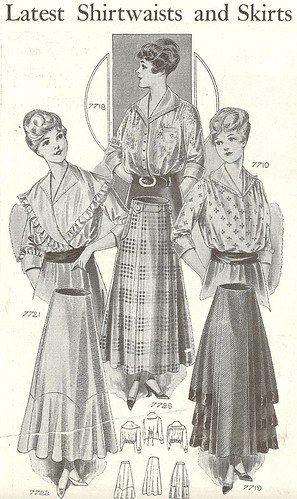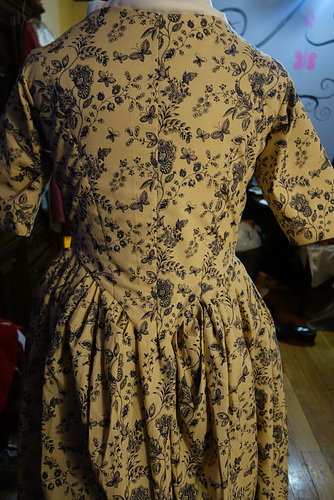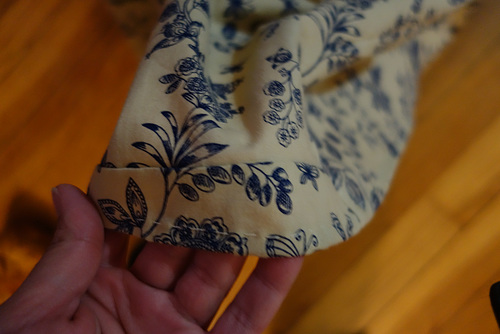My World War I outfit. I admit, the blouse front is pinned in the photo - I still can't decide if I want to add lace to the placket or not. However, the sleeves, shoulders, sides - everything else, is shown on the bodice. I just need to add a hook and eye to the skirt for that to be completely done as well.
The Challenge: War and Peace
Fabric: The pink of the skirt is cotton twill (Minna at Ikea), the black is black linen from Joanns, the blouse is out of embroidered cotton at joanns.
Pattern: My own! The skirt pattern and an explanation of it is below.
Year: 1915~
Notions: Lace collar, buttons, hook and eye, thread.
How historically accurate is it? They had cotton. They had linen. They had sewing machines. Really, from a visually accurate perspective, it's spot on.
Hours to complete: Maybe 10?
First worn: This Saturday! Better pictures then.
Total cost: The minna fabric was on sale for $3.49 a yard and I got 4 yards of that. I *think* the embroidered cotton was about $10 a yard, on sale, and I only got a yard and a half of that. The black linen was stash but it was a remnant I apparently paid $10 for. So...$38.96? The lace collar was in the stash.
The inspiration for the skirt:
On the lower right hand side, you'll see the tiered side skirt. This fashion plate is from 1916 but this style was popular as early as 1915. I *love* mid teens era styles. I adore those full skirts and blouses. They are just fabulous.
Below is the pattern I used for the skirt.
I know, the above drawing (done on paint!) is terrible, but I wanted to give an idea of what the pattern pieces were. From left to right: The first piece is the front and back. The front is cut on the fold and the back is cut with the selvage down the middle - this makes it easy to make it a back fastening skirt.
The middle two pieces are the sides. The longer one is the middle tier and the shorter one is the top tier. The waist for both is the same as the bottom tier (far right), but the overall width is "fatter" than the bottom tier. This gives the skirt the "puffy" affect that I needed. The bottom tier: the bottom 8" are a couple of inches wider than the rest of the piece. I cut along the dotted line and gathered the piece to the rest of the tier. This seam is hidden by the middle tier but gives the hem width I needed while still being narrow enough further up to give the puffy affect.
The waistband, not shown, was just a strip of the pink fabric with a double forked edge, and about 2" longer than the corseted waist measurement. I folded it over, sewed the two points (forks) together, to get a pointed waistband.
The black bands are just the bottom four inches of each of the tiers. I sewed those along the bottom edge of the wrong side, flipped them, ironed them, and then folded the top edge down, sewing the bands down on the right side of the fabric.
This ended up being a lot of material to sew through. The cotton twill is pretty heavy duty fabric (I got a blister on my finger just from cutting it out!) and sewing through the three tiers and the side and then adding in the waistband? Luckily, my sewing machine is awesome and went through all of this like it was butter.
The blouse is a pretty basic pattern. The big thing about the blouse isn't it's shape, it's how I achieved the color of it. Originally, it was a bright white but I really liked the embroidery pattern on the fabric and it's a nice 100% cotton semi-sheer - perfect for spring! The color didn't match a single one of my lace trims - it was just too white. So, I "aged" it using tea. I boiled a pot of tea in my soup pan. I used 8 bags of lipton tea and a bit of salt. Once the tea was dark enough, I turned the stove off, took out the tea bags, and put the fabric in, making sure it was completely submerged. I waited ten minutes, took it out and it was just the right shade. So, I hung it up to dry in the shower and then ironed it once it was completely dry. The color should stay.
As for the whole outfit, I'll probably wear a black belt of some sort around the waist to complete the look. We'll see Saturday!
Edit: Turns out the event was on Sunday, not Saturday. Still, it was a lot of fun!
One of the photos of Kat, myself, and Judy:
 |
| http://www.nsixty.com/video/display/view_key/1430680355 |
 |
| Taken by Kat |
I really love this outfit. It was so much fun (and so comfortable!) to wear. Even though I was wearing a corset (I didn't tie it very tight), I felt relaxed in this outfit. Just a nice long twill skirt with a simple blouse...over a corset cover, petticoat, corset, chemise, and drawers. ;-) Oh, and I had the black belt sash as well...and the hat I got at the thrift store. The hat was $6.90 and I added a feather. It came with the roses which matched the skirt perfectly. I was pleased. ;-)












.jpg)































